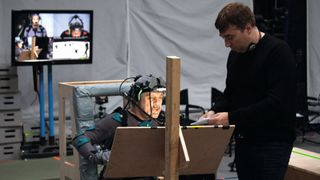Meeting the stars of Star Citizen

In June I spent two days at The Imaginarium motion capture studio at Ealing Studios, London. Founded in 2005 by actor Andy Serkis, it has been used for Avengers: Age of Ultron and Star Wars: The Force Awakens. It is also where Squadron 42’s substantial narrative component is being pieced together, using a cast that includes Mark Hamill, John Rhys-Davies, Gary Oldman, Gillian Anderson, Mark Strong, Andy Serkis and many others.
By the time I arrive filming has been progressing, on and off, for several months. Mark Hamill and John Rhys-Davies are working through what is left of their parts, and the production as a whole is coming to a close. It is the first time I have seen what over $100 million in funding looks like. That number can be difficult to parse, if you’re not a big-budget game producer. In Ealing, I learned that it looks like a lot of very expensive cameras, skintight suits covered in ping-pong balls, and a cast of top-flight actors.
Bolted onto Squadron 42’s open-ended structure is a scripted narrative told through conversations in the open world and story missions. That world-class motion-capture rig is being used to map the likenesses of the cast into the game, striking for the sense that you’re inside a sci-fi TV show. This is a modern way of achieving what Wing Commander struck for in the 1990s. FMV is gone, but Hamill and RhysDavies are back. They’re no longer Christopher Blair or Paladin (and the aliens are no longer men in giant cat costumes) but this really does feel like a spiritual successor.
“Right from the beginning it was something I wanted to do,” Chris Roberts says. “It’s fun—I haven’t done this in a game for quite a long time. We can take modern technology, fuse it with great acting... take it up a level, like Wing Commander took it up before.”
I find out while I’m there that Roberts and both actors became friends during the production of Wing Commander. For Mark Hamill, returning was easy. “I never expected to do this again with Chris specifically, but I had such a great time the first time around,” he tells me. “When he asked, I didn’t need to see the script. I said ‘count me in!’ Of course my agent said, ‘you didn’t tell him that, did you? Play hard to get for God’s sake!’”

Hamill plays Lt. Commander Steve ‘Old Man’ Colton, a veteran pilot and the player’s mentor. I watch Hamill record conversations and dogfight dialogue, and every story sequence ends with him barking a series of orders for the player to get into the next elevator or get to the next ship. “He’s a blunt guy, a lifer,” Hamill says. “They say he doesn’t teach people as much as hammer them into shape, but he’s a true believer in the cause. My father was in the Navy, I knew a lot of guys like this—lifers—no-nonsense guys. Sometimes resentful of the more educated college boys.”
I’m there for the filming of several conversations between Old Man and Rhys-Davies’ character, Graves, a former Navy colleague now working as a security chief for a private mining rig. Rhys-Davies describes Graves to me as “adrift in civvie street”: capable but a little compromised, cautious but willing to be dragged—by Old Man and the player—back into action. It’s fascinating watching the two actors work. Rhys-Davies is tall and highly charismatic, dropping in and out of Graves’ Scottish brogue as he jokes with the crew. Hamill is focused and attentive. Colton’s scowl falls across his face at the start of each take and lingers there for a while afterwards.
PC Gamer Newsletter
Sign up to get the best content of the week, and great gaming deals, as picked by the editors.
In the studio, scenes are played out on a grey mat covered in markings, with wooden frames and scaffolds standing in for desks, elevators and consoles. I watch Hamill record lines from the ‘cockpit’ of his ‘spaceship’, really a wooden chair that looks like an unimaginative child’s soapbox racer. The first time I saw Mark Hamill he was sitting in a hand-crafted X-Wing cockpit: the cultural and technological road from that image to this one is fascinating. While the motion-capture sets are rudimentary—even a little silly—the performances are rendered in real time onto monitors surrounding the stage. On these, I can see the detailed model of the ship Hamill is in, get a sense of the lighting and the mood.
It’s strange to see what the computer sees. It isn’t their image that is being recorded, but their presence—and not even fully that, as the real-life height difference between Hamill and Rhys-Davies is removed and body shapes are changed. It feels like some intangible essence of the real actors is being beamed into the game.
Joining in 2011, Chris made his start with PC Gamer turning beautiful trees into magazines, first as a writer and later as deputy editor. Once PCG's reluctant MMO champion , his discovery of Dota 2 in 2012 led him to much darker, stranger places. In 2015, Chris became the editor of PC Gamer Pro, overseeing our online coverage of competitive gaming and esports. He left in 2017, and can be now found making games and recording the Crate & Crowbar podcast.

